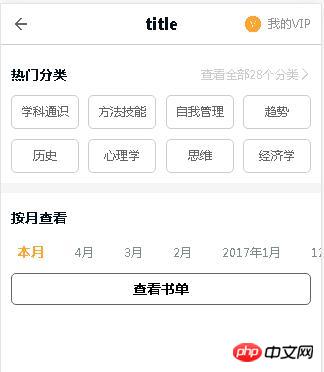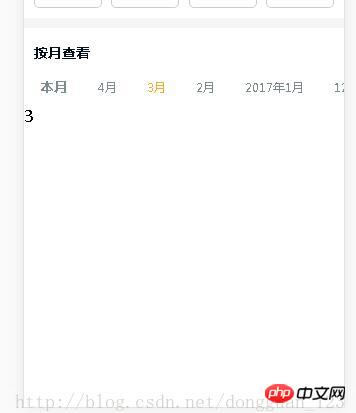Use vue to implement secondary route setting method
Now I will share with you a Vue secondary routing setting method, which has a good reference value and I hope it will be helpful to everyone.
Routing will definitely be used when using Vue in the project, and the requirements for secondary routing and even three-level routing are strictly needed. Of course, the configuration method of multi-level routing is the same as that of secondary routing. To put it simply Let’s talk about the configuration of secondary routing.
First prepare the structure of the first-level routing:
<router-link to="/discover"> <p @click="clickFind('发现')"> <span class="icon-find"></span> <p>发现</p> </p> </router-link> <router-link to="/todayStudy"> <p @click="clickStudy('今日学习')"> <span class="icon-todayStudy"></span> <p>今日学习</p> </p> </router-link> <router-link to="/listenAnyWhere"> <p @click="clickListen('随时听')"> <span class="icon-listenAny"></span> <p>随时听</p> </p> </router-link> <router-link to="/bought"> <p @click="clickBought('已购')"> <span class="icon-areadyBy"></span> <p>已购</p> </p> </router-link> <router-link to="/mine"> <p @click="clickMe"> <span class="icon-me"></span> <p>我</p> </p> </router-link> </p> <router-view></router-view>
Introduce the module in main.js, and Configure routing:
import discover from './components/discover/discover.vue'; import todayStudy from './components/todayStudy/study.vue'; import listen from './components/listenAnyWhere/listen.vue'; import bought from './components/bought/bought.vue'; import mine from './components/mine/mine.vue';
const routes = [
{
path: '/',
redirect: '/discover'
},
{
path: '/discover',
component: discover
},
{
path: '/todayStudy',
component: todayStudy
},
{
path: '/listenAnyWhere',
component: listen
},
{
path: '/bought',
component: bought
},
{
path: '/mine',
component: mine
}
];See the effect first


Click to enter the next level after listening to this book every day

Set the secondary route in main.js
import thisMouth from './components/discover/detailEveryDay/thisMouth/thisMouth.vue'; import four from './components/discover/detailEveryDay/fourth/fourth.vue'; import three from './components/discover/detailEveryDay/three/third.vue'; import two from './components/discover/detailEveryDay/two/second.vue'; import one from './components/discover/detailEveryDay/one/first.vue'; import twel from './components/discover/detailEveryDay/twe/twel.vue'; import elev from './components/discover/detailEveryDay/elven/elev.vue';
const routes = [
{
path: '/',
redirect: '/discover'
},
{
path: '/discover',
component: discover,
<span style="color:#ff0000;">children: [
{
path: '/',
component: thisMouth
},
{
path: '/thisMouth',
component: thisMouth
},
{
path: '/forthMouth',
component: four
},
{
path: '/thirdMouth',
component: three
},
{
path: '/secondMouth',
component: two
},
{
path: '/firstMouth',
component: one
},
{
path: '/elMouth',
component: twel
},
{
path: '/twMouth',
component: elev
}
]</span>
},Just create the modules required for each route under the corresponding path

The above is what I compiled for everyone. I hope it will be helpful to everyone in the future.
Related articles:
Using time plug-in and obtaining selection value in mint-ui
VUE2 realizes secondary province and city linkage selection
Select all in vue to implement data binding and acquisition
The above is the detailed content of Use vue to implement secondary route setting method. For more information, please follow other related articles on the PHP Chinese website!

Hot AI Tools

Undresser.AI Undress
AI-powered app for creating realistic nude photos

AI Clothes Remover
Online AI tool for removing clothes from photos.

Undress AI Tool
Undress images for free

Clothoff.io
AI clothes remover

Video Face Swap
Swap faces in any video effortlessly with our completely free AI face swap tool!

Hot Article

Hot Tools

Notepad++7.3.1
Easy-to-use and free code editor

SublimeText3 Chinese version
Chinese version, very easy to use

Zend Studio 13.0.1
Powerful PHP integrated development environment

Dreamweaver CS6
Visual web development tools

SublimeText3 Mac version
God-level code editing software (SublimeText3)

Hot Topics
 1671
1671
 14
14
 1428
1428
 52
52
 1331
1331
 25
25
 1276
1276
 29
29
 1256
1256
 24
24
 How to use bootstrap in vue
Apr 07, 2025 pm 11:33 PM
How to use bootstrap in vue
Apr 07, 2025 pm 11:33 PM
Using Bootstrap in Vue.js is divided into five steps: Install Bootstrap. Import Bootstrap in main.js. Use the Bootstrap component directly in the template. Optional: Custom style. Optional: Use plug-ins.
 How to add functions to buttons for vue
Apr 08, 2025 am 08:51 AM
How to add functions to buttons for vue
Apr 08, 2025 am 08:51 AM
You can add a function to the Vue button by binding the button in the HTML template to a method. Define the method and write function logic in the Vue instance.
 How to use watch in vue
Apr 07, 2025 pm 11:36 PM
How to use watch in vue
Apr 07, 2025 pm 11:36 PM
The watch option in Vue.js allows developers to listen for changes in specific data. When the data changes, watch triggers a callback function to perform update views or other tasks. Its configuration options include immediate, which specifies whether to execute a callback immediately, and deep, which specifies whether to recursively listen to changes to objects or arrays.
 How to return to previous page by vue
Apr 07, 2025 pm 11:30 PM
How to return to previous page by vue
Apr 07, 2025 pm 11:30 PM
Vue.js has four methods to return to the previous page: $router.go(-1)$router.back() uses <router-link to="/" component window.history.back(), and the method selection depends on the scene.
 React vs. Vue: Which Framework Does Netflix Use?
Apr 14, 2025 am 12:19 AM
React vs. Vue: Which Framework Does Netflix Use?
Apr 14, 2025 am 12:19 AM
Netflixusesacustomframeworkcalled"Gibbon"builtonReact,notReactorVuedirectly.1)TeamExperience:Choosebasedonfamiliarity.2)ProjectComplexity:Vueforsimplerprojects,Reactforcomplexones.3)CustomizationNeeds:Reactoffersmoreflexibility.4)Ecosystema
 What does vue multi-page development mean?
Apr 07, 2025 pm 11:57 PM
What does vue multi-page development mean?
Apr 07, 2025 pm 11:57 PM
Vue multi-page development is a way to build applications using the Vue.js framework, where the application is divided into separate pages: Code Maintenance: Splitting the application into multiple pages can make the code easier to manage and maintain. Modularity: Each page can be used as a separate module for easy reuse and replacement. Simple routing: Navigation between pages can be managed through simple routing configuration. SEO Optimization: Each page has its own URL, which helps SEO.
 How to use vue traversal
Apr 07, 2025 pm 11:48 PM
How to use vue traversal
Apr 07, 2025 pm 11:48 PM
There are three common methods for Vue.js to traverse arrays and objects: the v-for directive is used to traverse each element and render templates; the v-bind directive can be used with v-for to dynamically set attribute values for each element; and the .map method can convert array elements into new arrays.
 How to reference js file with vue.js
Apr 07, 2025 pm 11:27 PM
How to reference js file with vue.js
Apr 07, 2025 pm 11:27 PM
There are three ways to refer to JS files in Vue.js: directly specify the path using the <script> tag;; dynamic import using the mounted() lifecycle hook; and importing through the Vuex state management library.




